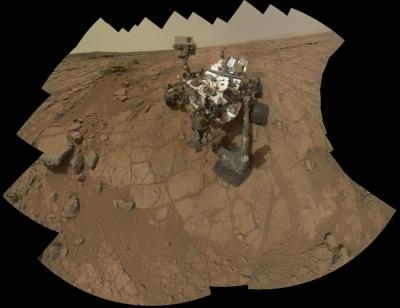Sat, Oct 19, 2013
Presence Of Two Forms Of Argon Detected By Curiosity Lead To Determination
Examination of the Martian atmosphere by NASA's Curiosity Mars rover confirms that some meteorites that have dropped to Earth really are from the Red Planet. A key new measurement of the inert gas argon in Mars' atmosphere by Curiosity's laboratory provides the most definitive evidence yet of the origin of Mars meteorites while at the same time providing a way to rule out Martian origin of other meteorites.

The new measurement is a high-precision count of two forms of argon -- argon-36 and argon-38 -- accomplished by the Sample Analysis at Mars (SAM) instrument inside the rover. These lighter and heavier forms, or isotopes, of argon exist naturally throughout the solar system. On Mars the ratio of light to heavy argon is skewed because much of that planet's original atmosphere was lost to space. The lighter form of argon was taken away more readily because it rises to the top of the atmosphere more easily and requires less energy to escape. That left the Martian atmosphere relatively enriched in the heavier isotope, argon-38.
Years of past analyses by Earth-bound scientists of gas bubbles trapped inside Martian meteorites had already narrowed the Martian argon ratio to between 3.6 and 4.5 (that is 3.6 to 4.5 atoms of argon-36 to every one of argon-38). Measurements by NASA's Viking landers in the 1970s put the Martian atmospheric ratio in the range of four to seven. The new SAM direct measurement on Mars now pins down the correct argon ratio at 4.2. "We really nailed it," said Sushil Atreya of the University of Michigan, Ann Arbor, lead author of an Oct. 16 paper reporting the finding in Geophysical Research Letters. "This direct reading from Mars settles the case with all Martian meteorites."
One reason scientists have been so interested in the argon ratio in Martian meteorites is that it was -- before Curiosity -- the best measure of how much atmosphere Mars has lost since the planet's wetter, warmer days billions of years ago. Figuring out the planet's atmospheric loss would enable scientists to better understand how Mars transformed from a once water-rich planet, more like our own, into today's drier, colder and less-hospitable world. Had Mars held onto all of its atmosphere and its original argon, its ratio of the gas would be the same as that of the sun and Jupiter. Those bodies have so much gravity that isotopes can't preferentially escape, so their argon ratio -- which is 5.5 -- represents that of the primordial solar system.
While argon makes up only a tiny fraction of the gas lost to space from Mars, it is special because it's a noble gas. That means the gas is inert, not reacting with other elements or compounds, and therefore a more straightforward tracer of the history of the Martian atmosphere. "Other isotopes measured by SAM on Curiosity also support the loss of atmosphere, but none so directly as argon," said Atreya. "Argon is the clearest signature of atmospheric loss because it's chemically inert and does not interact or exchange with the Martian surface or the interior. This was a key measurement that we wanted to carry out on SAM."
The Curiosity measurements do not directly measure the current rate of atmospheric escape, but NASA's next mission to Mars, the Mars Atmosphere and Volatile Evolution Mission (MAVEN), is designed to do so. That mission is being prepared at NASA's Kennedy Space Center in Florida for a launch-opportunity period that begins on Nov. 18.
(Image provided by NASA)
More News
Also: SkyReach Parts Support, Piper Service Ctr, Airliner Near-Miss, Airshow London The Judge overseeing Icon's convoluted Chapter 11 process has approved $9 million in Chapter 11 >[...]
ILS PRM Approach An instrument landing system (ILS) approach conducted to parallel runways whose extended centerlines are separated by less than 4,300 feet and at least 3,000 feet >[...]
Aero Linx: FlyPups FlyPups transports dogs from desperate situations to fosters, no-kill shelters, and fur-ever homes. We deliver trained dogs to veterans for service and companion>[...]
Also: Skydio Chief, Uncle Sam Sues, Dash 7 magniX, OR UAS Accelerator US Secretary of the Air Force Frank Kendall was given a turn around the patch in the 'X-62A Variable In-flight>[...]
Also: NBAA on FAA Reauth, DJI AG Drones, HI Insurance Bill Defeated, SPSA Airtankers The Beechcraft Denali continues moving forward towards certification, having received its FAA T>[...]
 Airborne 05.10.24: Icon Auction, Drunk MedEvac Pilot, Bell ALFA
Airborne 05.10.24: Icon Auction, Drunk MedEvac Pilot, Bell ALFA ANN's Daily Aero-Term (05.13.24): ILS PRM Approach
ANN's Daily Aero-Term (05.13.24): ILS PRM Approach ANN's Daily Aero-Linx (05.13.24)
ANN's Daily Aero-Linx (05.13.24) Airborne-NextGen 05.07.24: AI-Piloted F-16, AgEagle, 1st 2 WorldView Sats
Airborne-NextGen 05.07.24: AI-Piloted F-16, AgEagle, 1st 2 WorldView Sats Airborne 05.08.24: Denali Update, Dad-Daughter Gyro, Lake SAIB
Airborne 05.08.24: Denali Update, Dad-Daughter Gyro, Lake SAIB



